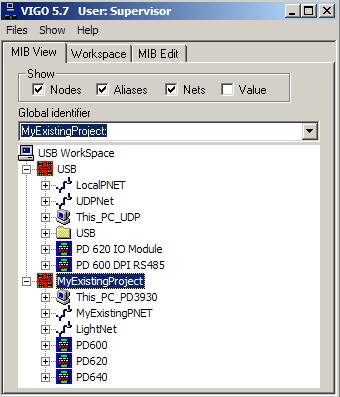VIGO - The Fieldbus Management System
VIGO is a suite of interrelated PC applications and utilities, which enables designers, and commissioning and maintenance engineers to configure, monitor and debug P-NET enabled systems. At its heart is the mechanism to enable communication between devices connected to P-NET (and other standards), and applications running in a PC. Such PC applications communicate internally by means of what is known as OLE2 Automation (Object Linking and Embedding), which is part of operating systems based on Microsoft Windows.
VIGO is so powerful and versatile that it is an essential tool when developing P-NET systems. As such, it is provided with a free licence when used with a PC/P-NET interface from PROCES-DATA.

The main user interface provides the means to build up the structure of a system using a variety of known and registered devices, in a tree structure. For example, if a cluster of 600 series devices is to be used, it is merely a matter of picking each node device type from a list and including it in the tree. Since the structure of each node device is known, VIGO knows how to access every register and what data type it contains. VIGO doesn’t know at this stage what the node address of each device is, or the name the user would like to call each device. This is achieved by using a property window for each device, where the user just fills in the required information. This procedure is carried out to include all nodes that will form the complete system, including 600 series clusters, other controllers and I/O nodes from other series, and any PCs.
Once the structure of a system has been defined, it is an easy matter to see or change the contents of each channel register. This can be done in 3 ways, either one register at a time by highlighting each register from the expanded tree (MIB view/value), by defining a list of multiple registers (Monitor), or by using one of the utilities which displays all the registers within a standard channel at the same time (Channel configuration).
Controllers and DPIs (masters) are slightly different to I/O type devices (slaves), in that they are programmable. Some of these also contain standard channels, but the user (programmer) can define his/her own data structures and operational software. Once a program has been devised, it can be downloaded to the controller via VIGO. However, VIGO now knows the data structure of the program and where to find specific values of variables held in the controller or DPI. A procedure is provided within VIGO to display such variables within the system tree structure. This means that such programmed variables can be monitored and changed in the same way as the facilities provided to monitor and control variables defined in standard I/O channels.
The VIGO suite of programs also provides facilities to scan the network to display the type and address of every node connected to the network. Also, it provides the means to change node addresses.
VIGO provides the ability to communicate via other communication standards. For example, two PCs can be connected via Ethernet, and transfer and display P-NET data between them. Also, P-NET data can be transferred between PCs over the Internet, assuming each PC has been set up to make such communication. Direct or dial-up connections can also be made, to transfer P-NET data using the PC’s RS232 ports via modems.
For more detailed information about the use of VIGO, refer to the VIGO manual, or the VIGO on-line help.
Related topics
Download
Products Providing a Free VIGO Licence
Info Note: Firewall warnings during VIGO installation
Visual VIGO – Visualisation and Data Acquisition
